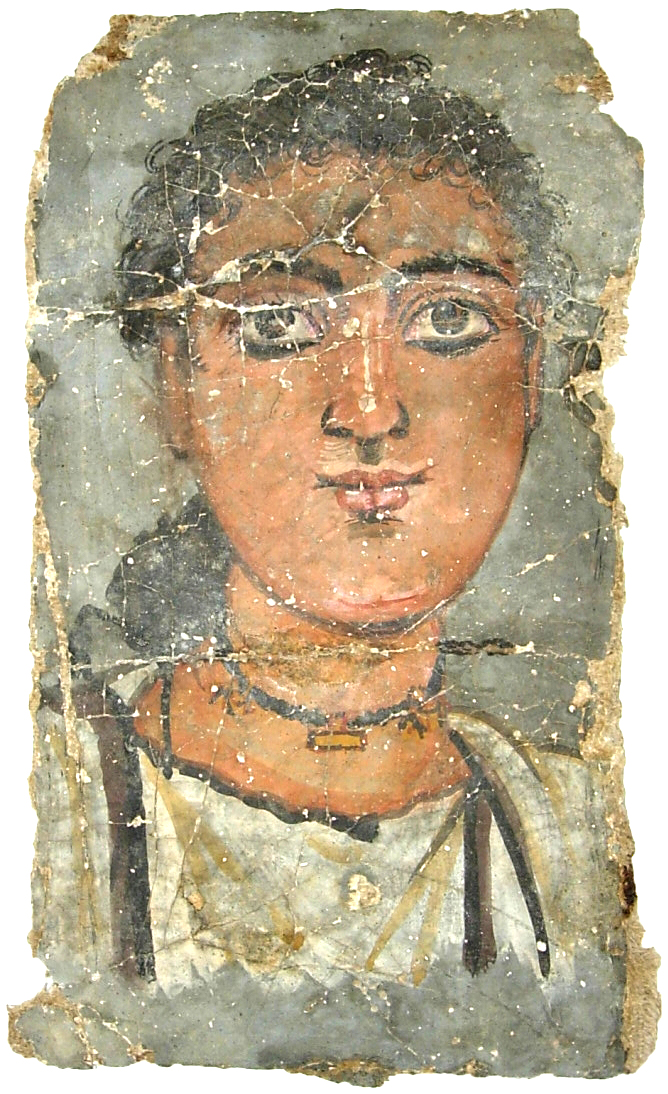Exhibit of the month
Fayum Portraits: Eternal faces of a cosmopolitan society
Portrait of a pre-adolescent boy
Νational Archaeological Museum
Collection of Egyptian Antiquities, inv. no AIG.1631
Provenance: Egypt, most probably from Er-Rubayat. From the donation of the collection of Giovanni Dimitriou to the National Archaeological Museum in 1880.
Dimensions: Height 26 cm, Width 15 cm, Thickness 2 mm.
Date: Third quarter of the 4th century AD
Display location: Exhibition of Egyptian Antiquities, Room 40, Showcase 20
Portrait of a pre-adolescent boy (9 to 13 years old), painted in tempera on linen cloth, stiffened with a thin layer of gesso and animal glue.
Against a bluish-grey background, a boy is depicted in three quarter view with a slight turn of his head to the right. He confronts the viewer directly with his big expressive eyes, glowing with a flame of immortality. The facial features are delicate and well-drawn. The long upper lip and the shorter fleshy lower lip suggest an origin from Er-Rubayat in the Fayoum oasis. His dark brown curly hair, in Greek style, frame the brow and are gathered to the side in the “Horus Lock”, a characteristic Egyptian hairstyle for children. The boys’ lock was cut at puberty, usually in the 14th year of age, in a rite of passage called the mallocouria (cutting of the hair), that marked the introduction of the elite teenagers in the Gymnasium to be instructed on Greek education, the key to economic success and social favour. The boy wears a white tunic with a brownish black band (clavus) on both sides, an indication of the upper class in the Roman world, and an off-white mantle folded over his left shoulder. Around his neck, according to Egyptian customs, he wears a leather cord with three gold pendant amulets: the busts of the divine couple Sarapis-Isis and in the middle the phylakterion, a small cylindrical case.
The realistic mummy portraits of men, women and children of all ages, well-known also as Fayum portraits are considered special and unique creations of a cosmopolitan multicultural society which flourished in Roman Egypt . They were popular from the 1st century AD to the 3rd or, according to other scholars, until the 4th century AD. They are painted by anonymous but brilliant artists on a thin panel of wood or linen cloth with two different Greek painting techniques: encaustic or tempera. Although they are stylistically associated with the tradition of Greco-Roman painting, they are created to serve an Egyptian ritual purpose: to replace the funerary three-dimensional mask on the mummies’ faces.
The Fayoum portraits capture, more impressively than other artworks, the personalities of the depicted members of the local elite of a cosmopolitan society, which played a number of different roles, according to the circumstances and their activities. In life, as Greeks in identity, they embraced the Greek language and culture. In life, as Romans serving the administration and the army, they followed the imperial fashion in clothing, hairstyles and jewellery. In death, as Egyptians, they desired to be sepulchered in a mummy form, like Osiris, to attain immortality.
Eleni Tourna
Archaeologist
Bibliography
Δήμητρα Παπανικόλα-Μπακιρτζή (επιμέλεια), Καθημερινή ζωή στο Βυζάντιο, Κατάλογος Έκθεσης, Θεσσαλονίκη Οκτώβριος 2001-Ιανουάριος 2002. Αθήνα 2002, σελ. 381-382, αρ. 465 (Ε.Τουρνά).
Klaus Parlasca, Rittratti di Mummie, Repertorio d’arte dell΄ Egitto Greco-Romano, Serie B, vol. III (1980) p.66, no.671.
Ευφροσύνη Δοξιάδη, Τα πορτρέτα του Φαγιούμ, Αθήνα 1996.


